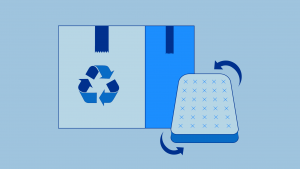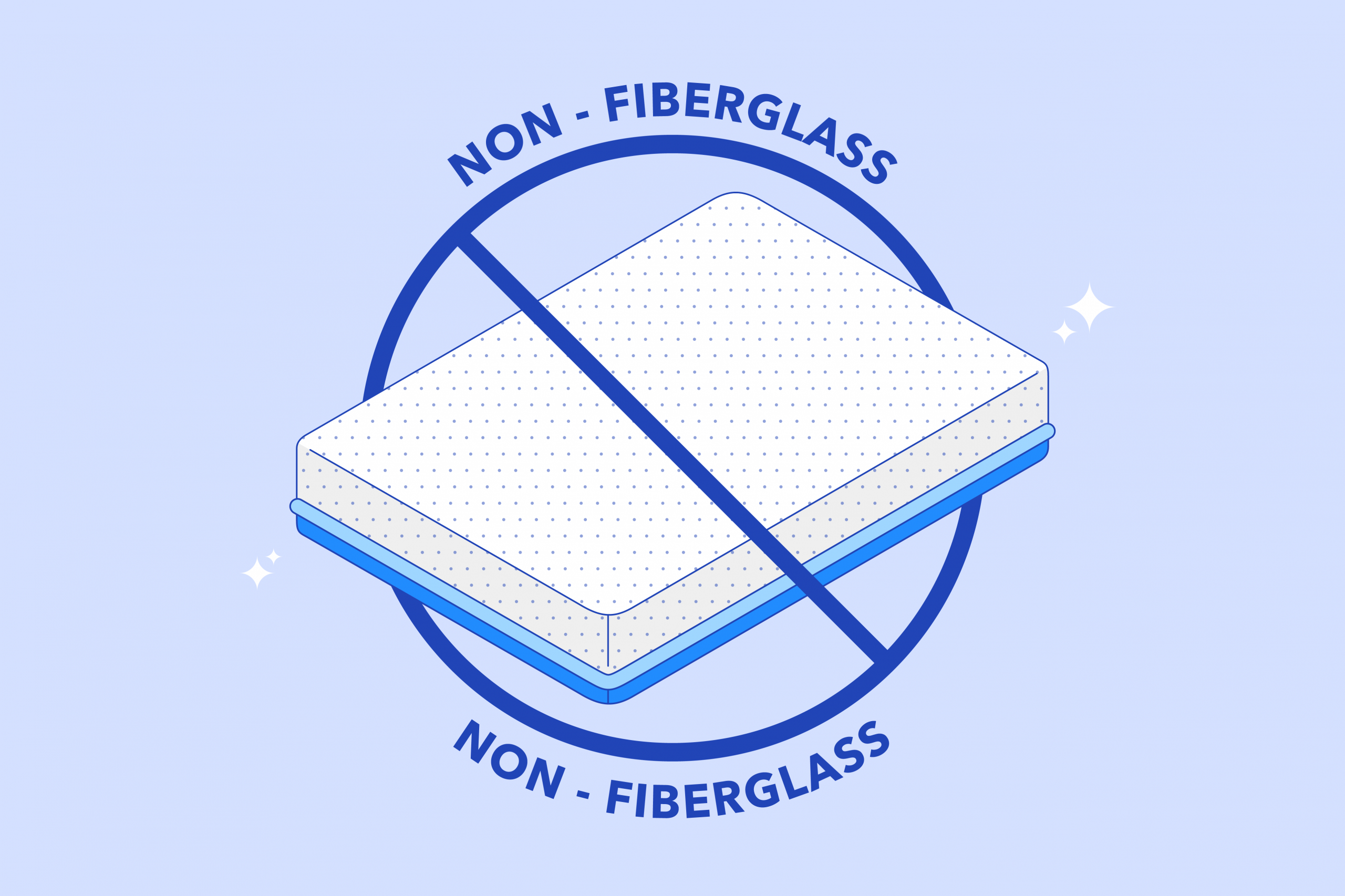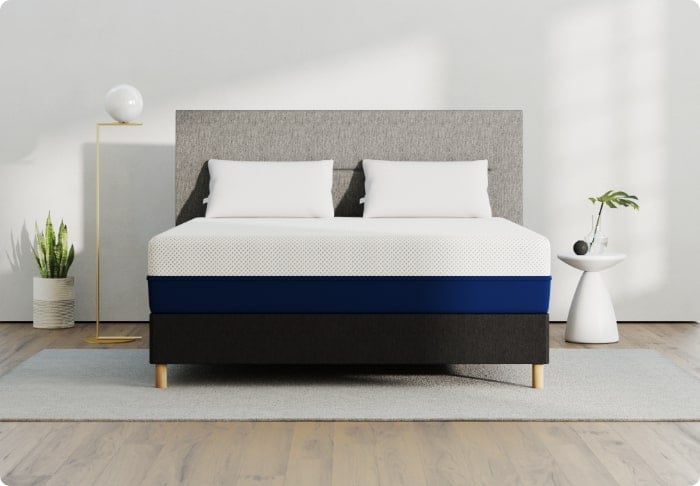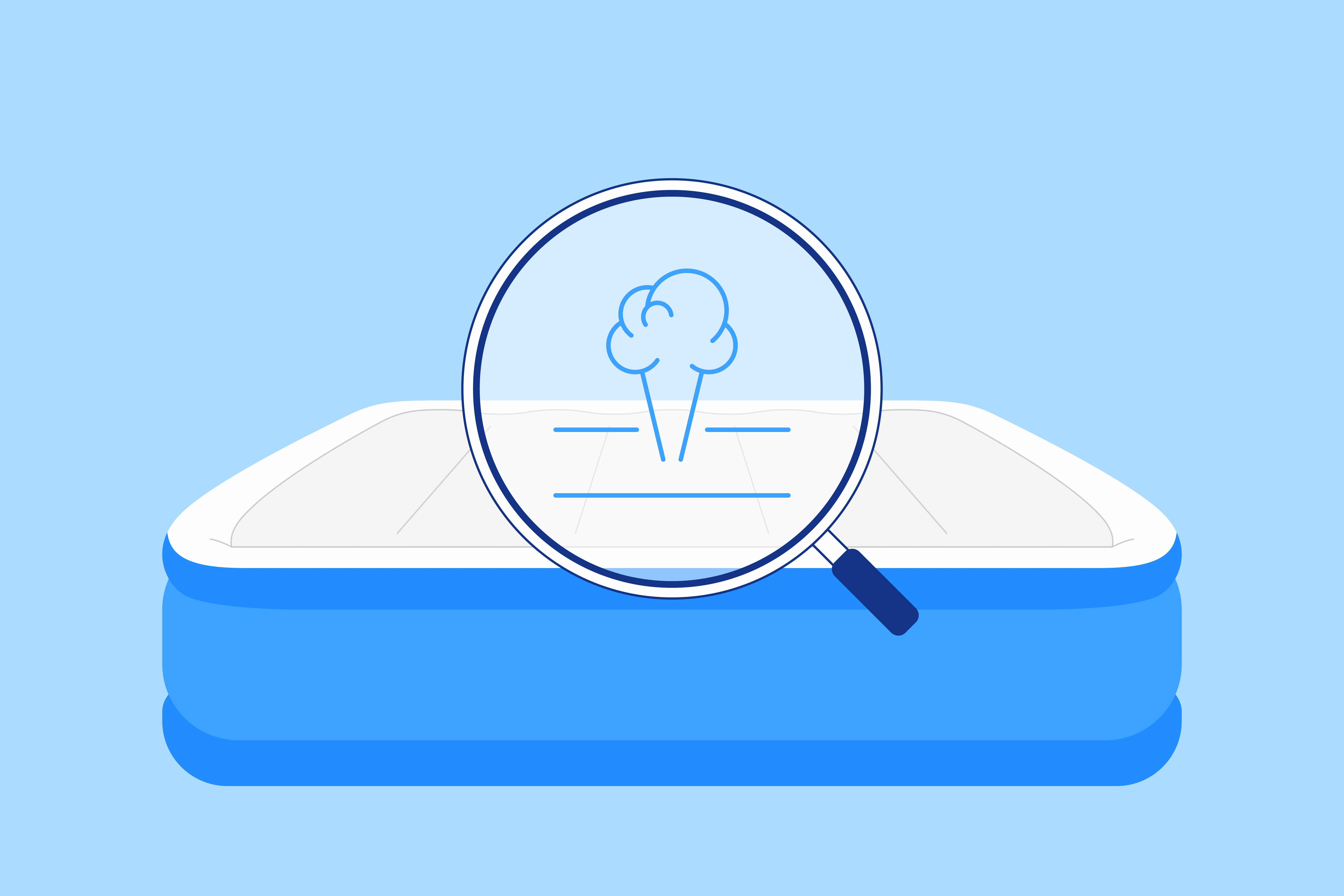Key Takeaways
- Fiberglass in Mattresses: Fiberglass is used in mattresses to serve as a fire safety feature, helping to prevent the spread of flames in case of a fire. While it is effective in this regard, concerns have arisen about its potential health risks when it escapes from the mattress.
- Health Concerns: Fiberglass exposure can lead to skin irritation, respiratory issues, and other discomforts. It’s important to avoid removing the mattress cover, as this can release fiberglass particles into the environment.
- Alternatives to Fiberglass: Many mattress manufacturers now offer options without fiberglass, using alternative flame-retardant materials like wool, plant fibers, and silica.
You may have heard of the fiberglass inside mattresses in a negative context, as concerns about this material have become more and more common in recent years. However, you may not know exactly what this material is or why it’s sparked controversy.
Fiberglass is, despite what the name implies, not pure glass. It’s a composite material that’s partly plastic and reinforced with glass fibers and synthetic chemicals. The material is used beyond just mattresses, such as in-home insulation since it works well as a thermal barrier.
“Sleeping on a mattress containing fiberglass poses potential health risks, including respiratory issues and skin irritation,” says Dr. Jordan Burns. “Research suggests that the sleep environment Verified Source ScienceDirect One of the largest hubs for research studies and has published over 12 million different trusted resources. View source significantly impacts sleep quality and overall health. Fiberglass particles can escape from mattresses and contaminate the bedroom environment, leading to poor air quality and potential health hazards.”
Best Mattresses Without Fiberglass
Quick Guide: A 30-Second Summary
| Best Mattress Without Fiberglass Overall | Amerisleep AS3 |
| Best Firm Mattress Without Fiberglass | Amerisleep AS2 |
| Best Soft Mattress Without Fiberglass | Amerisleep AS5 |
| Best Natural Mattress Without Fiberglass | Amerisleep Organica |
Why Do Mattresses Have Fiberglass?
Mattresses made in the U.S. must meet certain safety criteria when it comes to flammability. In the event of a fire, the fiberglass melts and coats the mattress’s insides, preventing the flame from spreading.
Naturally, fiberglass isn’t the only material that can stop a mattress from going up in flames. Chemical retardants were once common but are now banned due to toxicity concerns. Verified Source Environmental Protection Agency (EPA) Works to control/prevent natural and manmade disasters. View source Fiberglass became a popular choice to replace these chemicals.
Some chemical retardants that are considered harmful and dangerous include:
- Polybrominated Diphenyl Ethers (PBDEs)
- Boric acid
- Antimony trioxide
- Decabromodiphenyl oxide
- Melamine
- Vinylidene Chloride
- Organohalogen flame retardants or OFRs
Other alternatives to fiberglass are wool, plant fibers, and silica. Any one of these natural materials can serve as a mattress fire retardant, giving sleepers precious time to escape in an emergency.
Is it Safe for a Mattress to Have Fiberglass?
This isn’t quite as simple as a yes-or-no question because fiberglass is meant to be a fire safety feature during sleep. Fiberglass inside the mattress reduces the chances of the bed going up in flames if exposed to fire. As long as the fiberglass stays inside the mattress, the bed should be safe enough.
What if that fiberglass gets free, though? Well, there are no known long-term concerns of fiberglass exposure, it can lead to coughing, a sore throat, red eyes, stomach issues, itchiness, and other symptoms of irritation.
These are not major medical concerns, but they can negatively impact your quality of life. Particularly because once fiberglass gets free, it’s difficult to remove it all from a living area, finding its way into the crevices of a cluttered bedroom. So those irritation symptoms will continue to persist until your home is clean.
Where is Fiberglass Inside a Mattress Located?
Fiberglass is usually found underneath the cover fabric, as a shell wrapped around the foams and springs inside the mattress. The idea of this “inner cover” design is that if the outside of the mattress does catch fire, the fiberglass will quickly melt into a barrier, slowing the spread of the flame and ensuring a sleeper has time to move away.
Because the fiberglass layer is typically just under the cover fabric, many mattress manufacturers instruct owners to not remove the cover, even if there’s a zipper to do so. Slipping off the cover or needing to fix a ripped mattress can let the fiberglass shards underneath spread throughout your bedroom and even into the rest of your home.
However, while the fabric mattress cover should keep the fiberglass inside the mattress, some customers have complained that cheaply made mattresses can let the fiberglass leak through. Hence why many shoppers search for a nontoxic and chemical free mattress that doesn’t contain fiberglass.
What If My Mattress Has Fiberglass?
 What do you do if you learn the mattress you’re currently sleeping on has fiberglass? Fiberglass is non-toxic and should not harm you if it remains safely contained, so you can continue to sleep on your mattress as long as you never remove the mattress cover.
What do you do if you learn the mattress you’re currently sleeping on has fiberglass? Fiberglass is non-toxic and should not harm you if it remains safely contained, so you can continue to sleep on your mattress as long as you never remove the mattress cover.
If you’re concerned because your mattress contains fiberglass, we suggest wrapping it in a mattress protector until it’s time to replace the mattress. A mattress protector can help to contain any stray shards should the cover wear out, preventing the fiberglass from spreading and creating a mess that’s extremely difficult to clean up.
How do you know when your mattress needs replacing? A worn cover is definitely one sign and can let fiberglass leak through, but there are other ways to tell that a mattress is past its prime before you have to clean up mattress fiberglass.
Once you have your new mattress, then you can freely dispose of your unwanted fiberglass mattress. If you’re uncomfortable donating a mattress that has fiberglass to charities that accept gently used mattresses, we suggest looking into ways to recycle your mattress.
Many mattress recycling programs have been established to cut down on the number of mattresses heading to landfills, and parts such as steel springs can be repurposed into other objects.
Looking for a Mattress Free of Fiberglass?
Transparency is key when it comes to avoiding a fiberglass mattress. Many of the top mattress brands that are fiberglass-free give extensive information on where they source their materials and proudly state their mattresses are made in the USA.
Mattresses sold and assembled in the U.S. have to comply with strict product safety regulations that mattresses shipped from overseas can sidestep. Knowing a mattress’s construction and product history can boost confidence in any labels and certifications it has. The best places to buy a mattress should list this information openly or provide it freely upon request when you speak to a customer service representative.
Speaking of safety labels and certifications, some of the more common ones to keep an eye out for include:
- GOLS (Global Organic Latex Standard)
- GOTS (Global Organic Textile Standard)
- GREENGUARD Gold Certification
- CertiPUR-US®
- OEKO-TEX®
- Forest Stewardship Council®
- Rainforest Alliance
- eco-INSTITUT
While a low-cost mattress may be tempting if you’re on a budget, they typically lack the certifications and transparency that can inspire consumer confidence. You can save money without sacrificing quality and find an affordable eco-friendly mattress that’s free of fiberglass.
Researching a company’s reputation and reading through customer reviews can also guide you toward a mattress that’s right for you and does not contain fiberglass. It’s always smart to peruse customer reviews as a way to make sure you’re choosing one of the most comfortable mattresses available, so this is yet another reason to do your homework while shopping.
We do suggest you look at the most current reviews you can find, as many companies have abandoned using fiberglass in mattresses. Reviews that are a few years old or more may not give an accurate reflection of the mattress’s current construction, along with its comfort levels and expected durability.
We must also note that fiberglass isn’t always called fiberglass, and some manufacturers may still use it while calling it a different name. Other names for fiberglass particles that you may spot when reading a mattress tag include:
- Glass wool
- Glass fiber
- Glass-reinforced plastic (GRP)
- Glass-fiber reinforced plastic (GFRP)
- Fiberglass-reinforced plastic
Now when it comes to the types of mattresses that may contain fiberglass, some have more of a reputation for it than others. For example, memory foam mattresses may contain a fiberglass sock, as many memory foam manufacturers strive to produce an affordable bed. Cheaper polyfoam beds can also rely on fiberglass protection.
Meanwhile, many latex mattresses, particularly organic latex mattresses, have an inner wool layer that serves to cool the surface and enables the mattress to resist an open flame. Airbeds and waterbeds are also unlikely to contain fiberglass due to their construction.
However, that’s not to say that if you’re in the market for a memory foam mattress, you should give up on finding a fiberglass-free memory foam mattress. Plenty of memory foam mattresses are being made without fiberglass, especially as more shoppers and manufacturers have become concerned about the effects of fiberglass exposure.
“When selecting a mattress, I advise looking for certifications like CertiPUR-US® or GREENGUARD Gold, which indicate the product is free from harmful chemicals and substances, including fiberglass,” says Dr. Burns. “These certifications align with the American Academy of Sleep Medicine’s recommendations Verified Source American Academy of Sleep Medicine Society focused on sleep medicine and disorders, and the AASM is who authorizes U.S. sleep medicine facilities. View source for creating a sleep environment that supports health and well-being.”
Fiberglass Alternatives
Don’t settle for ordinary fiberglass mattresses! There’s a whole world of alternative materials out there waiting to be explored. Take wool, for example. It’s a natural flame-resistant material commonly found in organic latex mattresses, but it can be used in any type of mattress.
So, why is wool such a useful flame retardant for mattresses? Well, wool has a unique ability to retain moisture. And this moisture does more than just keep the surface of your mattress dry. It actually helps slow down the ignition process. When wool catches fire, it tends to smolder slowly instead of bursting into flames in an instant. This is why we use organic wool inside our latex Organica mattress.
Not only does natural or organic wool meet the flammability standards in the U.S., but it also offers temperature-neutral properties. It’s great at wicking away heat and moisture, ensuring a more comfortable sleep experience.
And if you’re looking for more options, there are other natural materials like thistle and flame-resistant plant fibers that can act as flame barriers too. In some cases, mattresses infused with graphite minerals not only keep you cool but also provide fire protection.
But it’s not just natural materials that can do the trick. Synthetic materials like polyester and rayon can also limit the spread of fire without relying on fiberglass. One remarkable example is Kevlar, a super strong plastic that doesn’t easily melt because of its unique structure. That’s why it can help safeguard your mattress against fire. Even when exposed to intense heat, Kevlar remains resilient.
“Beyond choosing a fiberglass-free mattress, consider factors like mattress firmness, which should support proper spinal alignment and materials that promote breathability and temperature regulation,” explains Dr. Burns. “Integrating these considerations can enhance sleep quality and contribute to overall musculoskeletal health, as a supportive sleep environment is crucial for the body’s nightly recovery processes.”
About Amerisleep Mattresses
Amerisleep’s mattresses are produced without fiberglass while still meeting all the necessary standards for sleeping safety. We offer memory foam, hybrid, and latex mattresses meant to suit various sleep styles.
We’ve been spotlighted by a number of sleep health blogs, such as:
- Healthy Americans who named our AS3 mattress their best mattress without fiberglass.
- Eachnight.com who also named the AS3 their top fiberglass free mattress with memory foam.
- TechRadar named the Amerisleep AS3 Hybrid as the best cooling mattress without fiberglass.
| Mattress | Price |
|---|---|
| AS1 | $899 |
| AS2 | $1099 |
| AS3 | $1299 |
| AS3 Hybrid | $1499 |
| AS4 | $1299 |
| AS5 | $1899 |
| AS5 Hybrid | $2199 |
| Amerisleep Organica | $1299 |
Aside from our fiberglass-free mattress design, there are other benefits to choosing an Amerisleep mattress. Our numbered line of mattresses features the following:
- A cover of Refresh fabric that’s meant to go beyond staying cool at night. This fabric features thermoreactive materials that convert body heat into infrared energy.
- Bio-Pur® foam, which is our innovative take on traditional memory foam. We replace some of the standard ingredients in memory foam with plant-derived substitutes. The result is a memory foam that’s more breathable and adaptable than most alternatives.
- Affinity foam with HIVE® technology serves as the transition layer in many of our models. Affinity foam is a buoyant material that creates a smoother surface feel and improves responsiveness, while the HIVE® technology establishes five distinct support zones. HIVE® ensures the bed feels soft where it’s wanted and firm where it’s needed.
- Pocketed coils provide the support of our hybrid mattresses, with every coil individually wrapped to better isolation motion. The drawback of a traditional innerspring mattress is how a sleeper’s every movement can be carried across the surface, so pocketed springs are important if you plan on sharing the bed.
- Alternatively, our memory foam mattresses feature a base of Bio-Core® foam. This foam is strong and resists sagging and body impressions, helping the mattress snap back into shape quickly.
Every Amerisleep mattress ships free and comes with a 100-night sleep trial and a 20-year warranty.
Comparing Mattress Brands and Fiberglass Use
| Mattress Brand | Do They Use Fiberglass? |
|---|---|
| Allswell | Yes |
| AmazonBasics | Yes |
| Amerisleep | No |
| Amorebeds | No |
| Ashley Mattresses | Yes |
| Avenco | No |
| Avocado | No |
| Awara | No |
| Bear | No |
| Best Price Mattress | Yes |
| Big Fig | No |
| Birch | No |
| Brentwood Home | No |
| Brooklyn Bedding | No |
| Casper | Yes |
| Classic Brands | Yes |
| Crystli | Yes |
| Dynasty Mattress | No |
| Eco Terra | No |
| Eight Sleep | Yes |
| Emma | Yes |
| Essentia | No |
| Full Moon | Yes |
| GhostBed | Yes |
| Happsy | No |
| Helix | No |
| Joybed | No |
| Keetsa | No |
| Latex for Less | No |
| Layla | Yes |
| Leesa | Yes |
| Linenspa | Yes |
| Lucid | Yes |
| Lull | Yes |
| Mainstays | Yes |
| Maxim | No |
| Minocasa | No |
| Mlily | No |
| Molblly | Yes |
| Molecule | Yes |
| My Green Mattress | No |
| NapQueen | Yes |
| Natural Form | No |
| Naturepedic | No |
| Nectar | Yes |
| Nest Bedding | No |
| Nolah | No |
| Novilla | No |
| Oleesleep | Yes |
| Perfect Cloud | Yes |
| Plushbeds | No |
| Puffy | Yes |
| Purple | No |
| Saatva | No |
| Sealy | Yes |
| Siena | Yes |
| Signature Sleep | Yes |
| Silk & Snow | No |
| Sleep Innovations | Yes |
| Sleep Number | Possibly, but uncertain |
| Sleepy’s by Mattress Firm | Yes |
| Spindle | No |
| Stearns & Foster | Yes |
| Sunrising Bedding | No |
| Sweetnight | No |
| Tempurpedic | Yes |
| Tuft & Needle | No |
| tulo by Mattress Firm | Yes |
| Vaya | No |
| Vibe | Yes |
| WinkBeds | No |
| Zinus | Yes |
| Zoma | No |
Other Mattress Buying Considerations
Mattress Firmness
Mattress firmness is an essential factor to consider for different sleep positions. Here’s a brief overview of the ideal mattress firmness levels for each sleeping style.
Side Sleepers
Side sleepers typically benefit from a mattress with medium to medium-soft firmness. Such mattresses for side sleepers allow for proper contouring and pressure relief, particularly in areas like the shoulders and hips. A mattress that is too firm may create discomfort and affect spinal alignment.
Back Sleepers
Back sleepers generally require a mattress with a medium to medium-firm firmness. These mattresses for back sleeping help maintain proper spinal alignment and prevent sinking too deeply into the mattress. A mattress that is too soft may cause the sleeper’s lower back to sag, leading to discomfort over time.
Stomach Sleepers
Stomach sleepers often prefer a mattress with medium-firm to firm firmness. This level of firmness provides the necessary support to keep the spine properly aligned and prevent excessive sinking of the stomach and pelvis area. A mattress that is too soft can cause the spine to curve unnaturally, leading to potential discomfort and strain.
Combination Sleepers
Combination sleepers, who frequently change positions during the night, typically benefit from a medium firmness mattress. A medium-feel mattress offers a balance between support and pressure relief, accommodating different sleep positions and movements. Mattresses for combination sleeping allow for proper spinal alignment while also contouring to the body’s curves.
Mattress Types
When it comes to choosing a mattress, there are several types available, each offering unique characteristics and benefits. Let’s explore the most common types of mattresses: memory foam mattresses, latex mattresses, hybrid mattresses, and innerspring mattresses.
Memory Foam Mattresses
Memory foam mattresses are known for their excellent pressure-relieving properties. They are made from a viscoelastic material that molds and contours to the body’s shape, providing personalized support. Memory foam mattresses distribute weight evenly, reducing pressure points and relieving discomfort. This type of mattress also absorbs motion, making it a suitable choice for couples or individuals who share a bed.
Furthermore, memory foam mattresses can provide superior spinal alignment, alleviating back and joint pain. However, some people may find that memory foam mattresses retain heat, so it’s advisable to look for models with cooling features like gel memory foam or advanced open-cell construction to mitigate this issue.
Latex Mattresses
Latex mattresses are crafted from natural latex or a blend of natural and synthetic latex. Natural latex is derived from the sap of rubber trees, making it an eco-friendly option. Latex mattresses offer a unique balance of support and responsiveness. They provide a buoyant and bouncy feel, allowing for easy movement and repositioning during sleep.
Latex mattresses are also durable and resistant to allergens such as dust mites and mold. Additionally, they have good breathability, promoting airflow and heat dissipation, which can help regulate body temperature. It’s important to note that latex mattresses may be pricier compared to other types, but their longevity and comfort make them a worthwhile investment.
Innerspring Mattresses
Innerspring mattresses are among the most traditional and widely available types of mattresses. They consist of a core support system made of metal coils or springs, topped with layers of padding for comfort. Innerspring mattresses offer a responsive and firm feel. The coil system allows for proper airflow, which can help regulate body temperature during sleep.
These mattresses are known for their durability and mattress edge support, allowing sleepers to utilize the full surface of the bed without feeling like they might roll off. However, they may not provide as much contouring or pressure relief as memory foam or latex mattresses. Additionally, some individuals may find that innerspring mattresses transfer more motion compared to other types.
Hybrid Mattresses
Hybrid mattresses combine the best of both worlds by integrating memory foam or latex layers with innerspring coils. These mattresses aim to offer a balance between support, pressure relief, and responsiveness. The top comfort layers typically consist of memory foam or latex to provide contouring and pressure relief, while the innerspring coils in the support core deliver stability, support, and enhanced airflow.
Hybrid mattresses are designed to cater to various sleep preferences, making them suitable for a wide range of individuals. They are a popular choice for those seeking the benefits of both foam and innerspring mattresses. However, it’s important to note that hybrid mattresses may be more expensive compared to other options due to their construction and materials.
Air Mattresses & Waterbeds
Inflatable air mattresses are a popular and affordable choice for those in need of a bed for guests or for travel. They come in a wide range of options, from basic ones that simply hold air to more advanced models with multiple air chambers and smart technology features.
One advantage of air mattresses is that they are unlikely to contain fiberglass. This is not just because glass particles could potentially cause a leak in the mattress. The Consumer Product Safety Commission (CPSC) states that air mattresses are not required to meet flammability standards unless they have upholstery material between the ticking and mattress core.
Similarly, waterbeds are also exempt from U.S. flammability requirements unless they have upholstery material. Therefore, it is unlikely for a waterbed to contain fiberglass. However, it’s important to note that waterbeds may raise other concerns for shoppers, such as the potential mess in the event of a leak and the time-consuming process of filling them with water.
Frequently Asked Questions
Why is fiberglass used in mattresses?
Fiberglass is used in mattresses to limit the potential of a deadly fire. It was meant as an alternative to chemical flame retardants, which later fell out of favor as their health risks became well-known. Fiberglass was appealing because it was inexpensive and non-toxic, while also providing protection that could save people’s lives during a fire.
However, fiberglass has become criticized as a material for not being completely free of harm. Many mattress owners have reported skin irritation and temporary respiratory issues after removing a bed’s outer cover.
Does memory foam contain fiberglass?
The memory foam itself does not contain fiberglass. CertiPUR-US®, a common certification for high-quality memory foam mattresses, even notes that their seal means a foam doesn’t contain fiberglass.
However, just because there isn’t fiberglass inside the foam doesn’t mean a memory foam mattress lacks fiberglass entirely. The fiberglass typically encases the foams as a separate layer, so shoppers need to look for the best memory foam mattresses without fiberglass.
How can I tell if my mattress has fiberglass?
Often, mattress manufacturers won’t openly advertise that their mattresses contain fiberglass. Still, an observant shopper can often spot the signs of a mattress with fiberglass. If they don’t refer to it as fiberglass, they may call it “glass wool” or “glass fibers.”
Another warning sign is a manufacturer stressing that mattress owners should not remove the cover. Removing the cover can let fiberglass escape, and this exposure to fiberglass can cause a number of health issues. So even if a mattress brand won’t openly say their mattresses have fiberglass, non-removable mattress covers should put a shopper’s guard up.
What mattresses don’t use fiberglass?
Organic latex mattresses used to be the most certain way to get a fiberglass-free mattress. Instead of fiberglass, these eco-friendly mattresses tended to rely on flame-resistant wool or plant fibers.
However, it’s quite possible now to find all types of mattresses made without fiberglass, from memory foam to hybrids and even traditional innerspring mattresses.
Do all mattresses have fiberglass in them?
No, not all mattresses have fiberglass inside them, particularly as the drawbacks of fiberglass become more understood. However, the material is still used as an affordable way for mattresses in the U.S. to meet federal safety standards.
Fiberglass is relatively inexpensive and it is quite effective as a non-chemical flame retardant. So it remains, for now at least, a common ingredient in mattresses.
Conclusion
More and more mattress shoppers are becoming aware of the potential risks to fiberglass, with a greater demand for mattresses free of fiberglass. Though it’s non-toxic, fiberglass can cause severe discomfort if it escapes its mattress.
If you do have a mattress with fiberglass, though, it’s not the end of the world. You can make sure not only to never remove the mattress cover, but even encase it in the additional barrier a mattress protector offers. This can provide some peace of mind until you’re ready to purchase a mattress without fiberglass.
About the author
Mitchell Tollsen is a graduate student and a freelance writer who’s contributed to the Early Bird blog for three years. Mitchell’s always been fascinated by the science of sleep and the restorative processes our bodies undergo when at rest. The self-titled “Sleep Expert” is always looking for ways to improve his shut-eye, and throughout the years has implemented numerous lifestyle changes and tried dozens of sleep-promoting gadgets to determine the best ways to truly get better rest.
View all posts





